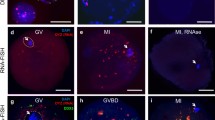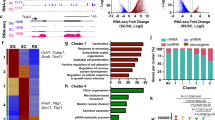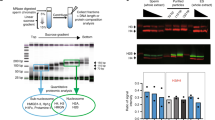Abstract
The genes for ribosomal RNA exist as multiple copies in the genome. Each repeated unit comprises a region that codes for the 40S rRNA precursor, and a spacer region of uncertain function1,2 (Fig. 1a). In Xenopus laevis there are about 1,000 copies of the dinucleotide sequence C-G in each repeat unit, and of these about 250 can be tested for the presence of 5-methylcytosine using restriction endonucleases3,4. Most of the detectable C-Gs are heavily methylated, but in somatic cells unmethylated C-Gs occur5 in a 60 base pair (bp) sequence (NTS-60) that is repeated in the spacer6,7 In contrast, the spacer of sperm rDNA is heavily methylated at these and all other testable C-Gs. Loss of methylation at NTS-60 takes place during the first day of embryonic development, near the time when rDNA transcription begins4. In an attempt to assess the significance of this developmental change in methylation, we have isolated sperm rDNA and investigated whether it can be transcribed in oocytes. We have found that sperm rDNA is transcribed as efficiently as cloned rDNA, although no loss of methylation was detectable. Direct sequencing of sperm rDNA showed that all 19 C-Gs in the promoter are highly methylated. Thus, in the case of rDNA injected into oocytes, loss of methylation is unnecessary for effective transcription.
This is a preview of subscription content, access via your institution
Access options
Subscribe to this journal
Receive 51 print issues and online access
$199.00 per year
only $3.90 per issue
Buy this article
- Purchase on Springer Link
- Instant access to full article PDF
Prices may be subject to local taxes which are calculated during checkout
Similar content being viewed by others
References
Lewin, B. Gene Expression Vol. 2 p. 865 (Wiley, New York, 1980).
Long, E. & David. I. B. A. Rev. Biochem. 49, 727–764 (1980).
Bird, A. P. & Southern, E. M. J. molec. Biol. 118, 27–47 (1978).
Bird, A. P., Taggart, M. H. & Macleod, D. Cell 26, 381–390 (1981).
La Volpe, A., Taggart, M. H., Macleod, D. & Bird, A. P. Cold Spring Harb. Symp. quant. Biol. 47, 585–592 (1982).
Boseley, P. G., Moss, T., Machler, M., Portmann, R. & Birnstiel, M. L. Cell 17, 19–31 (1979).
Sollner-Webb, B. & Reeder, R. H. Cell 18, 485–499 (1979).
Birnstiel, M. L., Wallace, H., Sirlin, J. L & Fischberg, M. Natn. Cancer. Inst. Monogr. 23, 431–447 (1966).
Gruenbaum, Y., Stein, R., Cedar, H. & Razin, A. FEBS. Lett. 124, 67–71 (1981).
Moss, T. Cell 30, 835–842 (1982).
Sollner-Webb, B. & McKnight, S. L. Nucleic Acids Res. 10, 3391–3405 (1982).
Southern, E. M. J. molec. Biol. 98, 503–517 (1975).
Vardimon, L., Kressmann, A., Cedar, H., Maechler, M. & Doerfler, W. Proc. natn. Acad. Sci. U.S.A. 79, 1073–1077 (1982).
Fradin, A., Manley, J. L. & Prives, C. L. Proc. natn. Acad. Sci. U.S.A. 79, 5142–5146 (1982).
Berk, A. J. & Sharp, P. A. Cell 12, 721–732 (1977).
Moss, T. Nature 302, 223–228 (1983).
Maxam, A. M. & Gilbert, W. Meths Enzymol. 65, 499–560 (1980).
Moss, T., Boseley, P. G. & Birnstiel, M. L. Nucleic Acids Res. 8, 467–485 (1980).
Brown, D. D. & Gurdon, J. Proc. natn. Acad. Sci. U.S.A. 74, 2064–2068 (1977).
Fedoroff, N. V. & Brown, D. D. Cell 13, 701–716 (1978).
Miller, J. R., Cartwright, E. M., Brownlee, G. G., Fedoroff, N. V. & Brown, D. D. Cell 13, 717–725 (1978).
Stuhlmann, H., Jahner, D. & Jaenisch, R. Cell 26, 221–232 (1981).
Cedar, H. et al. Cold Spring Harb. Symp. quant. Biol. 47, 605–609 (1983).
Busby, S. & Reeder, R. H. (1983) Cell (in the press).
Bird, A. P., Taggart, M. H. & Gehring, C. J. molec. Biol. 152, 1–17 (1981).
Newport, J. & Kirschner, M. Cell 30, 675–686 (1982).
Kressman, A., Clarkson, S. G. & Telford, J. L. Cold Spring Harb. Symp. quant. Biol. 42, 1077–1082 (1978).
Dawid, I. B., Brown, D. D. & Reeder, R. H. J. molec. Biol. 51, 341–360 (1970).
Birnstiel, M. L., Sells, B. H. & Purdom, I. F. J. molec. Biol. 63, 21–39 (1972).
Author information
Authors and Affiliations
Rights and permissions
About this article
Cite this article
Macleod, D., Bird, A. Transcription in oocytes of highly methylated rDNA from Xenopus laevis sperm. Nature 306, 200–203 (1983). https://doi.org/10.1038/306200a0
Received:
Accepted:
Issue Date:
DOI: https://doi.org/10.1038/306200a0
This article is cited by
-
Epigenetic silencing of RNA polymerase I transcription
Nature Reviews Molecular Cell Biology (2003)
-
Biological aspects of cytosine methylation in eukaryotic cells
Experientia (1991)
-
Repair-modification and evolution of the eukaryotic genome organization
Cell Biophysics (1989)
-
Methylation of ribosomal cistrons in diploid and tetraploid Odontophrynus americanus (Amphibia, Anura)
Chromosoma (1989)
-
Long-range restriction site mapping of mammalian genomic DNA
Nature (1986)
Comments
By submitting a comment you agree to abide by our Terms and Community Guidelines. If you find something abusive or that does not comply with our terms or guidelines please flag it as inappropriate.



